Antimicrobial Susceptibility Profile and Whole-Genome Analysis of a Strong Biofilm-Forming Bacillus Sp. B87 Strain Isolated from Food
Abstract
1. Introduction
2. Materials and Methods
2.1. Bacterial Strains and Culture Conditions
2.2. Biofilm Formation Assay
2.3. Antimicrobial Susceptibility Tests
2.4. Whole-Genome Sequencing, Assembly, and Annotation
2.5. Phylogenetic Analysis
2.6. Nucleotide Sequence Accession Numbers
3. Results
3.1. Biofilm-Forming Ability of Bacillus Sp. B87
3.2. Antimicrobial Resistance Profile of Bacillus Sp. B87
3.3. Genetic Features of Bacillus Sp. B87
3.4. Antimicrobial Resistance Genes
3.5. Biofilm Formation Genes
3.6. Virulence Factor Genes
4. Discussion
5. Conclusions
Supplementary Materials
Author Contributions
Funding
Institutional Review Board Statement
Informed Consent Statement
Data Availability Statement
Acknowledgments
Conflicts of Interest
References
- Ehling-Schulz, M.; Frenzel, E.; Gohar, M. Food-bacteria interplay: Pathometabolism of emetic Bacillus cereus. Front. Microbiol. 2015, 6, 704. [Google Scholar] [CrossRef] [PubMed]
- Stenfors Arnesen, L.P.; Fagerlund, A.; Granum, P.E. From soil to gut: Bacillus cereus and its food poisoning toxins. FEMS Microbiol. Rev. 2008, 32, 579–606. [Google Scholar] [CrossRef] [PubMed]
- Gohar, M.; Faegri, K.; Perchat, S.; Ravnum, S.; Okstad, O.A.; Gominet, M.; Kolsto, A.B.; Lereclus, D. The PlcR virulence regulon of Bacillus cereus. PLoS ONE 2008, 3, e2793. [Google Scholar] [CrossRef] [PubMed]
- de Been, M.; Francke, C.; Moezelaar, R.; Abee, T.; Siezen, R.J. Comparative analysis of two-component signal transduction systems of Bacillus cereus, Bacillus thuringiensis and Bacillus anthracis. Microbiology 2006, 152 Pt 10, 3035–3048. [Google Scholar] [CrossRef]
- Citron, D.M.; Appleman, M.D. In Vitro activities of daptomycin, ciprofloxacin, and other antimicrobial agents against the cells and spores of clinical isolates of Bacillus species. J. Clin. Microbiol. 2006, 44, 3814–3818. [Google Scholar] [CrossRef][Green Version]
- Park, Y.B.; Kim, J.B.; Shin, S.W.; Kim, J.C.; Cho, S.H.; Lee, B.K.; Ahn, J.; Kim, J.M.; Oh, D.H. Prevalence, genetic diversity, and antibiotic susceptibility of Bacillus cereus strains isolated from rice and cereals collected in Korea. J. Food. Prot. 2009, 72, 612–617. [Google Scholar] [CrossRef]
- Jensen, L.B.; Baloda, S.; Boye, M.; Aarestrup, F.M. Antimicrobial resistance among Pseudomonas spp. and the Bacillus cereus group isolated from Danish agricultural soil. Environ. Int. 2001, 26, 581–587. [Google Scholar] [CrossRef]
- Luna, V.A.; King, D.S.; Gulledge, J.; Cannons, A.C.; Amuso, P.T.; Cattani, J. Susceptibility of Bacillus anthracis, Bacillus cereus, Bacillus mycoides, Bacillus pseudomycoides and Bacillus thuringiensis to 24 antimicrobials using Sensititre automated microbroth dilution and Etest agar gradient diffusion methods. J. Antimicrob. Chemother. 2007, 60, 555–567. [Google Scholar] [CrossRef]
- Rutherford, S.T.; Bassler, B.L. Bacterial quorum sensing: Its role in virulence and possibilities for its control. Cold Spring Harb Perspect. Med. 2012, 2, a012427. [Google Scholar] [CrossRef]
- Gomes, F.; Saavedra, M.J.; Henriques, M. Bovine mastitis disease/pathogenicity: Evidence of the potential role of microbial biofilms. Pathog. Dis. 2016, 74, ftw006. [Google Scholar] [CrossRef]
- McCarthy, H.; Rudkin, J.K.; Black, N.S.; Gallagher, L.; O’Neill, E.; O’Gara, J.P. Methicillin resistance and the biofilm phenotype in Staphylococcus aureus. Front. Cell Infect. Microbiol. 2015, 5, 1. [Google Scholar] [CrossRef] [PubMed]
- Ikram, S.; Heikal, A.; Finke, S.; Hofgaard, A.; Rehman, Y.; Sabri, A.N.; Okstad, O.A. Bacillus cereus biofilm formation on central venous catheters of hospitalised cardiac patients. Biofouling 2019, 35, 204–216. [Google Scholar] [CrossRef] [PubMed]
- Fagerlund, A.; Smith, V.; Rohr, A.K.; Lindback, T.; Parmer, M.P.; Andersson, K.K.; Reubsaet, L.; Okstad, O.A. Cyclic diguanylate regulation of Bacillus cereus group biofilm formation. Mol. Microbiol. 2016, 101, 471–494. [Google Scholar] [CrossRef] [PubMed]
- Gelis-Jeanvoine, S.; Canette, A.; Gohar, M.; Caradec, T.; Lemy, C.; Gominet, M.; Jacques, P.; Lereclus, D.; Slamti, L. Genetic and functional analyses of krs, a locus encoding kurstakin, a lipopeptide produced by Bacillus thuringiensis. Res. Microbiol. 2017, 168, 356–368. [Google Scholar] [CrossRef] [PubMed]
- Sudarsan, N.; Lee, E.R.; Weinberg, Z.; Moy, R.H.; Kim, J.N.; Link, K.H.; Breaker, R.R. Riboswitches in eubacteria sense the second messenger cyclic di-GMP. Science 2008, 321, 411–413. [Google Scholar] [CrossRef]
- Tang, Q.; Yin, K.; Qian, H.; Zhao, Y.; Wang, W.; Chou, S.H.; Fu, Y.; He, J. Cyclic di-GMP contributes to adaption and virulence of Bacillus thuringiensis through a riboswitch-regulated collagen adhesion protein. Sci. Rep. 2016, 6, 28807. [Google Scholar] [CrossRef]
- Sornchuer, P.; Tiengtip, R. Prevalence, virulence genes, and antimicrobial resistance of Bacillus cereus isolated from foodstuffs in Pathum Thani Province, Thailand. Pharm. Sci. Asia 2021, 48, 194–203. [Google Scholar] [CrossRef]
- Hsueh, Y.H.; Somers, E.B.; Lereclus, D.; Wong, A.C. Biofilm formation by Bacillus cereus is influenced by PlcR, a pleiotropic regulator. Appl. Environ. Microbiol. 2006, 72, 5089–5092. [Google Scholar] [CrossRef]
- Clinical and Laboratory Standards Institute. Performance Standards for Antimicrobial Susceptibility Testing, 20th Informational Supplement; CLSI Document M100-S20; CLSI: Wayne, PA, USA, 2010. [Google Scholar]
- Gao, T.; Ding, Y.; Wu, Q.; Wang, J.; Zhang, J.; Yu, S.; Yu, P.; Liu, C.; Kong, L.; Feng, Z.; et al. Prevalence, virulence genes, antimicrobial susceptibility, and genetic diversity of Bacillus cereus isolated from pasteurized milk in China. Front. Microbiol. 2018, 9, 533. [Google Scholar] [CrossRef]
- Moriya, Y.; Itoh, M.; Okuda, S.; Yoshizawa, A.C.; Kanehisa, M. KAAS: An automatic genome annotation and pathway reconstruction server. Nucleic Acids Res. 2007, 35, W182-5. [Google Scholar] [CrossRef]
- Sullivan, M.J.; Petty, N.K.; Beatson, S.A. Easyfig: A genome comparison visualizer. Bioinformatics 2011, 27, 1009–1010. [Google Scholar] [CrossRef] [PubMed]
- Fiedler, G.; Herbstmann, A.D.; Doll, E.; Wenning, M.; Brinks, E.; Kabisch, J.; Breitenwieser, F.; Lappann, M.; Bohnlein, C.; Franz, C. Taxonomic evaluation of the Heyndrickxia (Basonym Bacillus) sporothermodurans Group (H. sporothermodurans, H. vini, H. oleronia) based on whole genome sequences. Microorganisms 2021, 9, 246. [Google Scholar] [CrossRef] [PubMed]
- Meier-Kolthoff, J.P.; Goker, M. TYGS is an automated high-throughput platform for state-of-the-art genome-based taxonomy. Nat. Commun. 2019, 10, 2182. [Google Scholar] [CrossRef] [PubMed]
- Liu, Y.; Du, J.; Lai, Q.; Zeng, R.; Ye, D.; Xu, J.; Shao, Z. Proposal of nine novel species of the Bacillus cereus group. Int. J. Syst. Evol. Microbiol. 2017, 67, 2499–2508. [Google Scholar] [CrossRef] [PubMed]
- Granum, P.E.; O’Sullivan, K.; Lund, T. The sequence of the non-haemolytic enterotoxin operon from Bacillus cereus. FEMS Microbiol. Lett. 1999, 177, 225–229. [Google Scholar] [CrossRef]
- Beecher, D.J.; Wong, A.C.L. Tripartite haemolysin BL: Isolation and characterization of two distinct homologous sets of components from a single Bacillus cereus isolate. Microbiology 2000, 146 Pt 6, 1371–1380. [Google Scholar] [CrossRef]
- Lund, T.; De Buyser, M.L.; Granum, P.E. A new cytotoxin from Bacillus cereus that may cause necrotic enteritis. Mol. Microbiol. 2000, 38, 254–261. [Google Scholar] [CrossRef]
- Hansen, B.M.; Hendriksen, N.B. Detection of enterotoxic Bacillus cereus and Bacillus thuringiensis strains by PCR analysis. Appl. Environ. Microbiol. 2001, 67, 185–189. [Google Scholar] [CrossRef]
- Fagerlund, A.; Ween, O.; Lund, T.; Hardy, S.P.; Granum, P.E. Genetic and functional analysis of the cytK family of genes in Bacillus cereus. Microbiology 2004, 150 Pt 8, 2689–2697. [Google Scholar] [CrossRef]
- Sergeev, N.; Distler, M.; Vargas, M.; Chizhikov, V.; Herold, K.E.; Rasooly, A. Microarray analysis of Bacillus cereus group virulence factors. J. Microbiol. Methods 2006, 65, 488–502. [Google Scholar] [CrossRef]
- Hernandez, A.G.C.; Ortiz, V.G.; Gomez, J.L.A.; Lopez, M.A.R.; Morales, J.A.R.; Macias, A.F.; Hidalgo, E.A.; Ramirez, J.N.; Gallardo, F.J.F.; Gutierrez, M.C.G.; et al. Detection of Bacillus cereus sensu lato isolates posing potential health risks in Mexican chili powder. Microorganisms 2021, 9, 2226. [Google Scholar] [CrossRef] [PubMed]
- Salamitou, S.; Ramisse, F.; Brehelin, M.; Bourguet, D.; Gilois, N.; Gominet, M.; Hernandez, E.; Lereclus, D. The plcR regulon is involved in the opportunistic properties of Bacillus thuringiensis and Bacillus cereus in mice and insects. Microbiology 2000, 146 Pt 11, 2825–2832. [Google Scholar] [CrossRef]
- Lindback, T.; Okstad, O.A.; Rishovd, A.L.; Kolsto, A.B. Insertional inactivation of hblC encoding the L2 component of Bacillus cereus ATCC 14579 haemolysin BL strongly reduces enterotoxigenic activity, but not the haemolytic activity against human erythrocytes. Microbiology 1999, 145 Pt 11, 3139–3146. [Google Scholar] [CrossRef] [PubMed]
- Chen, Y.; Luo, Y.; Curry, P.; Timme, R.; Melka, D.; Doyle, M.; Parish, M.; Hammack, T.S.; Allard, M.W.; Brown, E.W.; et al. Assessing the genome level diversity of Listeria monocytogenes from contaminated ice cream and environmental samples linked to a listeriosis outbreak in the United States. PLoS ONE 2017, 12, e0171389. [Google Scholar] [CrossRef] [PubMed]
- Chung, H.Y.; Lee, K.H.; Ryu, S.; Yoon, H.; Lee, J.H.; Kim, H.B.; Kim, H.; Jeong, H.G.; Choi, S.H.; Kim, B.S. Genome Sequence of Bacillus cereus FORC_021, a Food-Borne Pathogen Isolated from a Knife at a Sashimi Restaurant. J. Microbiol. Biotechnol. 2016, 26, 2030–2035. [Google Scholar] [CrossRef]
- Owusu-Kwarteng, J.; Wuni, A.; Akabanda, F.; Tano-Debrah, K.; Jespersen, L. Prevalence, virulence factor genes and antibiotic resistance of Bacillus cereus sensu lato isolated from dairy farms and traditional dairy products. BMC Microbiol. 2017, 17, 65. [Google Scholar] [CrossRef]
- Fiedler, G.; Schneider, C.; Igbinosa, E.O.; Kabisch, J.; Brinks, E.; Becker, B.; Stoll, D.A.; Cho, G.S.; Huch, M.; Franz, C. Antibiotics resistance and toxin profiles of Bacillus cereus-group isolates from fresh vegetables from German retail markets. BMC Microbiol. 2019, 19, 250. [Google Scholar] [CrossRef]
- Chen, Y.; Succi, J.; Tenover, F.C.; Koehler, T.M. Beta-lactamase genes of the penicillin-susceptible Bacillus anthracis Sterne strain. J. Bacteriol. 2003, 185, 823–830. [Google Scholar] [CrossRef]
- Hawk, M.J.; Breece, R.M.; Hajdin, C.E.; Bender, K.M.; Hu, Z.; Costello, A.L.; Bennett, B.; Tierney, D.L.; Crowder, M.W. Differential binding of Co(II) and Zn(II) to metallo-beta-lactamase Bla2 from Bacillus anthracis. J. Am. Chem. Soc. 2009, 131, 10753–10762. [Google Scholar] [CrossRef]
- Page, M.I.; Badarau, A. The mechanisms of catalysis by metallo beta-lactamases. Bioinorg. Chem. Appl. 2008, 2008, 576297. [Google Scholar] [CrossRef]
- Felici, A.; Amicosante, G.; Oratore, A.; Strom, R.; Ledent, P.; Joris, B.; Fanuel, L.; Frere, J.M. An overview of the kinetic parameters of class B beta-lactamases. Biochem. J. 1993, 291 Pt 1, 151–155. [Google Scholar] [CrossRef] [PubMed]
- You, Y.; Hilpert, M.; Ward, M.J. Identification of Tet45, a tetracycline efflux pump, from a poultry-litter-exposed soil isolate and persistence of tet(45) in the soil. J. Antimicrob. Chemother. 2013, 68, 1962–1969. [Google Scholar] [CrossRef] [PubMed]
- Rather, M.; Aulakh, R.; Munshi, Z.H.; Hussain, S.; Shah, s.; Wani, N. Antibiogram and detection of tetracycline resistance genes (tetA, tetB) of Bacillus cereus from foods of animal origin. SKUAST J. Res. 2015, 17, 99–105. [Google Scholar]
- Agerso, Y.; Jensen, L.B.; Givskov, M.; Roberts, M.C. The identification of a tetracycline resistance gene tet(M), on a Tn916-like transposon, in the Bacillus cereus group. FEMS Microbiol. Lett. 2002, 214, 251–256. [Google Scholar] [CrossRef]
- Bernhard, K.; Schrempf, H.; Goebel, W. Bacteriocin and antibiotic resistance plasmids in Bacillus cereus and Bacillus subtilis. J. Bacteriol. 1978, 133, 897–903. [Google Scholar] [CrossRef] [PubMed]
- Eccles, S.J.; Chopra, I. Biochemical and genetic characterization of the tet determinant of Bacillus plasmid pAB124. J. Bacteriol. 1984, 158, 134–140. [Google Scholar] [CrossRef]
- Ives, C.L.; Bott, K.F. Cloned Bacillus subtilis chromosomal DNA mediates tetracycline resistance when present in multiple copies. J. Bacteriol. 1989, 171, 1801–1810. [Google Scholar] [CrossRef]
- Auger, S.; Krin, E.; Aymerich, S.; Gohar, M. Autoinducer 2 affects biofilm formation by Bacillus cereus. Appl. Environ. Microbiol. 2006, 72, 937–941. [Google Scholar] [CrossRef]
- Oosthuizen, M.C.; Steyn, B.; Theron, J.; Cosette, P.; Lindsay, D.; Von Holy, A.; Brozel, V.S. Proteomic analysis reveals differential protein expression by Bacillus cereus during biofilm formation. Appl. Environ. Microbiol. 2002, 68, 2770–2780. [Google Scholar] [CrossRef]
- Peng, J.S.; Tsai, W.C.; Chou, C.C. Surface characteristics of Bacillus cereus and its adhesion to stainless steel. Int. J. Food Microbiol. 2001, 65, 105–111. [Google Scholar] [CrossRef]
- Peng, J.S.; Tsai, W.C.; Chou, C.C. Inactivation and removal of Bacillus cereus by sanitizer and detergent. Int. J. Food Microbiol. 2002, 77, 11–18. [Google Scholar] [CrossRef]
- Abe, K.; Nomura, N.; Suzuki, S. Biofilms: Hot spots of horizontal gene transfer (HGT) in aquatic environments, with a focus on a new HGT mechanism. FEMS Microbiol. Ecol. 2020, 96, fiaa031. [Google Scholar] [CrossRef] [PubMed]
- Salcedo, D.; Lee, J.; Ha, U.-H.; Kim, S. The effects of antibiotics on the biofilm formation and antibiotic resistance gene transfer. Desalination Water Treat. 2014, 54, 3582–3588. [Google Scholar] [CrossRef]
- Stachurová, T.; Malachová, K.; Semerád, J.; Sterniša, M.; Rybková, Z.; Smole Možina, S. Tetracycline induces the formation of biofilm of bacteria from different phases of wastewater treatment. Processes 2020, 8, 989. [Google Scholar] [CrossRef]
- Slamti, L.; Lereclus, D. A cell-cell signaling peptide activates the PlcR virulence regulon in bacteria of the Bacillus cereus group. EMBO J. 2002, 21, 4550–4559. [Google Scholar] [CrossRef]
- Ryu, J.H.; Beuchat, L.R. Biofilm formation and sporulation by Bacillus cereus on a stainless steel surface and subsequent resistance of vegetative cells and spores to chlorine, chlorine dioxide, and a peroxyacetic acid-based sanitizer. J. Food Prot. 2005, 68, 2614–2622. [Google Scholar] [CrossRef] [PubMed]
- Lindback, T.; Mols, M.; Basset, C.; Granum, P.E.; Kuipers, O.P.; Kovacs, A.T. CodY, a pleiotropic regulator, influences multicellular behaviour and efficient production of virulence factors in Bacillus cereus. Environ. Microbiol. 2012, 14, 2233–2246. [Google Scholar] [CrossRef]
- Hsueh, Y.H.; Somers, E.B.; Wong, A.C. Characterization of the codY gene and its influence on biofilm formation in Bacillus cereus. Arch. Microbiol. 2008, 189, 557–568. [Google Scholar] [CrossRef]
- Yan, F.; Yu, Y.; Gozzi, K.; Chen, Y.; Guo, J.H.; Chai, Y. Genome-wide investigation of biofilm formation in Bacillus cereus. Appl. Environ. Microbiol. 2017, 83, e00561-17. [Google Scholar] [CrossRef]
- Candela, T.; Fagerlund, A.; Buisson, C.; Gilois, N.; Kolsto, A.B.; Okstad, O.A.; Aymerich, S.; Nielsen-Leroux, C.; Lereclus, D.; Gohar, M. CalY is a major virulence factor and a biofilm matrix protein. Mol. Microbiol. 2019, 111, 1416–1429. [Google Scholar] [CrossRef]
- Kearns, D.B.; Chu, F.; Branda, S.S.; Kolter, R.; Losick, R. A master regulator for biofilm formation by Bacillus subtilis. Mol. Microbiol. 2005, 55, 739–749. [Google Scholar] [CrossRef] [PubMed]
- Majed, R.; Faille, C.; Kallassy, M.; Gohar, M. Bacillus cereus biofilms-same, only different. Front. Microbiol. 2016, 7, 1054. [Google Scholar] [CrossRef] [PubMed]
- Caro-Astorga, J.; Perez-Garcia, A.; de Vicente, A.; Romero, D. A genomic region involved in the formation of adhesin fibers in Bacillus cereus biofilms. Front. Microbiol. 2014, 5, 745. [Google Scholar] [CrossRef] [PubMed]
- Bianco, A.; Capozzi, L.; Monno, M.R.; Del Sambro, L.; Manzulli, V.; Pesole, G.; Loconsole, D.; Parisi, A. Characterization of Bacillus cereus group isolates from human bacteremia by whole-genome sequencing. Front. Microbiol. 2021, 11, 599524. [Google Scholar] [CrossRef] [PubMed]
- Karunakaran, E.; Biggs, C.A. Mechanisms of Bacillus cereus biofilm formation: An investigation of the physicochemical characteristics of cell surfaces and extracellular proteins. Appl. Microbiol. Biotechnol. 2011, 89, 1161–1175. [Google Scholar] [CrossRef]
- Whitfield, G.B.; Marmont, L.S.; Bundalovic-Torma, C.; Razvi, E.; Roach, E.J.; Khursigara, C.M.; Parkinson, J.; Howell, P.L. Discovery and characterization of a Gram-positive Pel polysaccharide biosynthetic gene cluster. PLoS Pathog. 2020, 16, e1008281. [Google Scholar] [CrossRef]
- Gao, T.; Ding, M.; Wang, Q. The recA gene is crucial to mediate colonization of Bacillus cereus 905 on wheat roots. Appl. Microbiol. Biotechnol. 2020, 104, 9251–9265. [Google Scholar] [CrossRef]
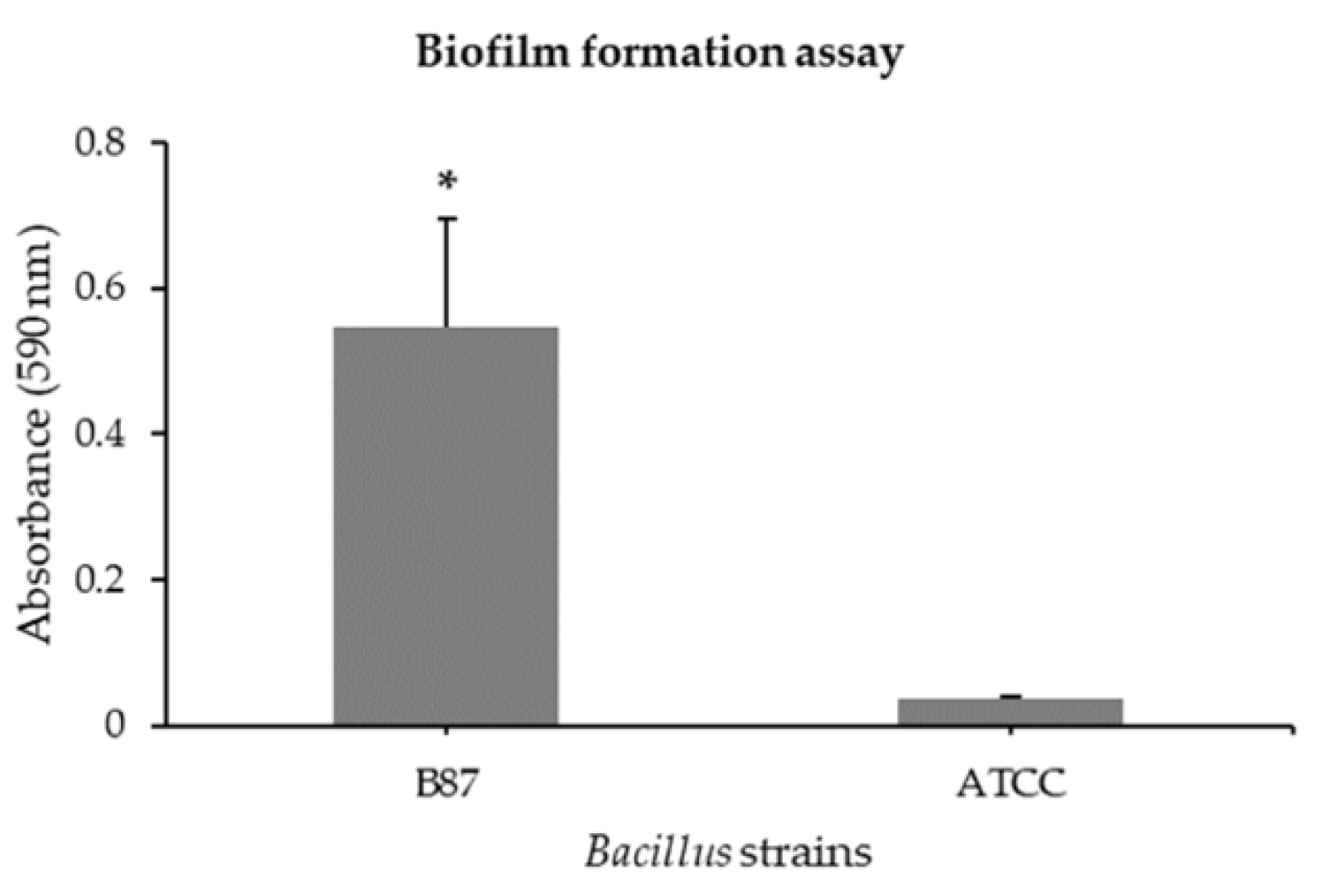
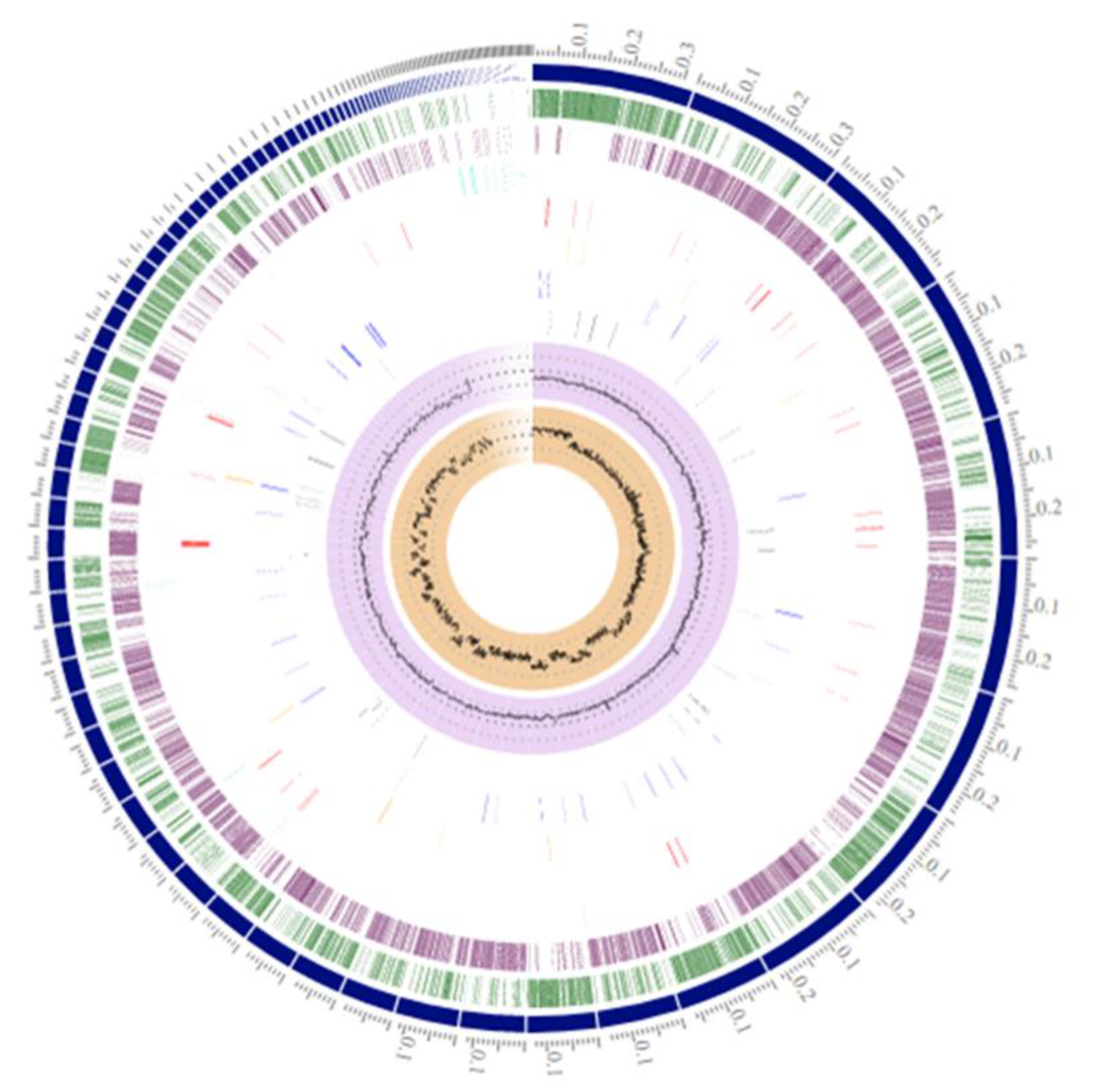
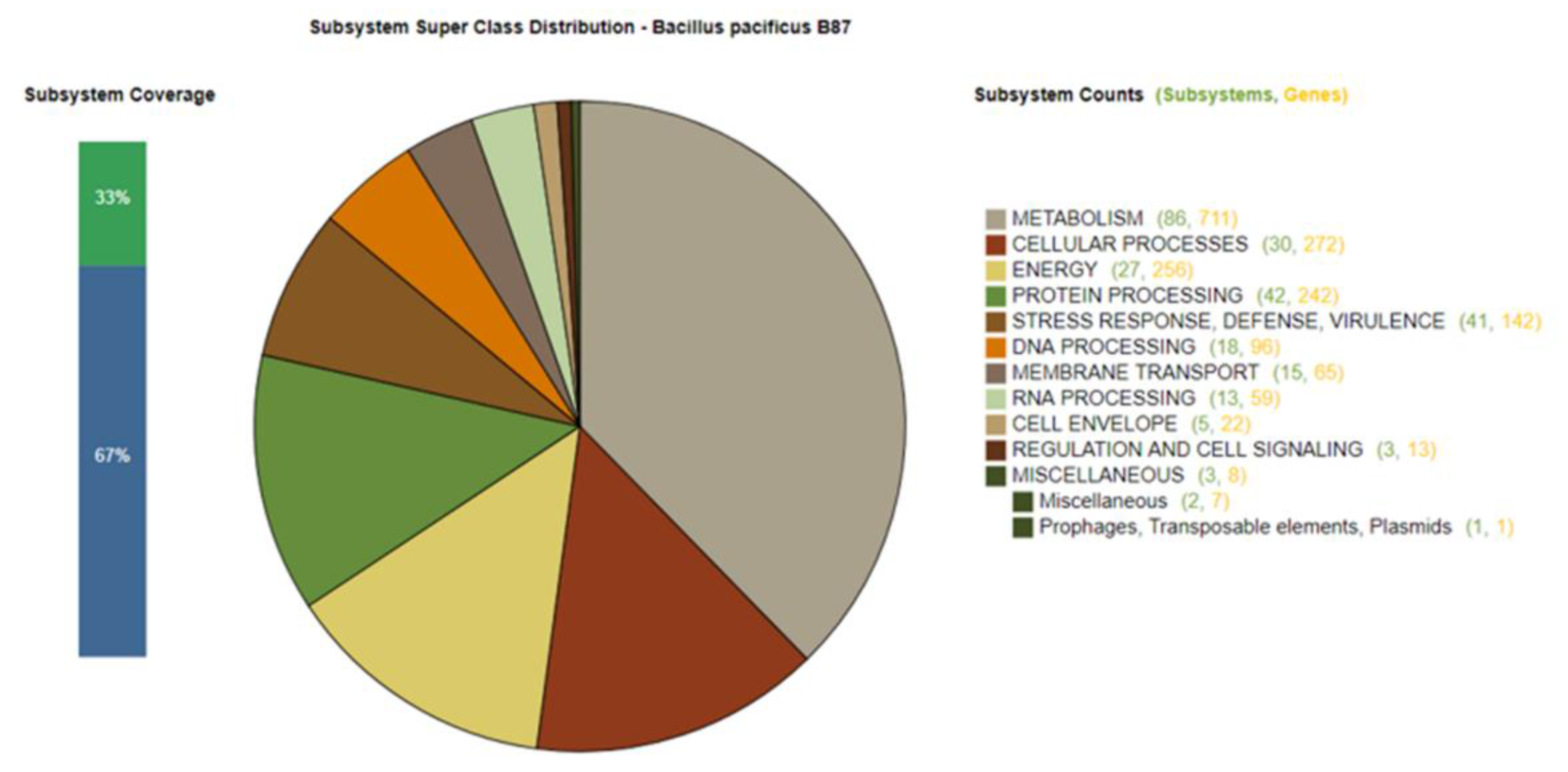
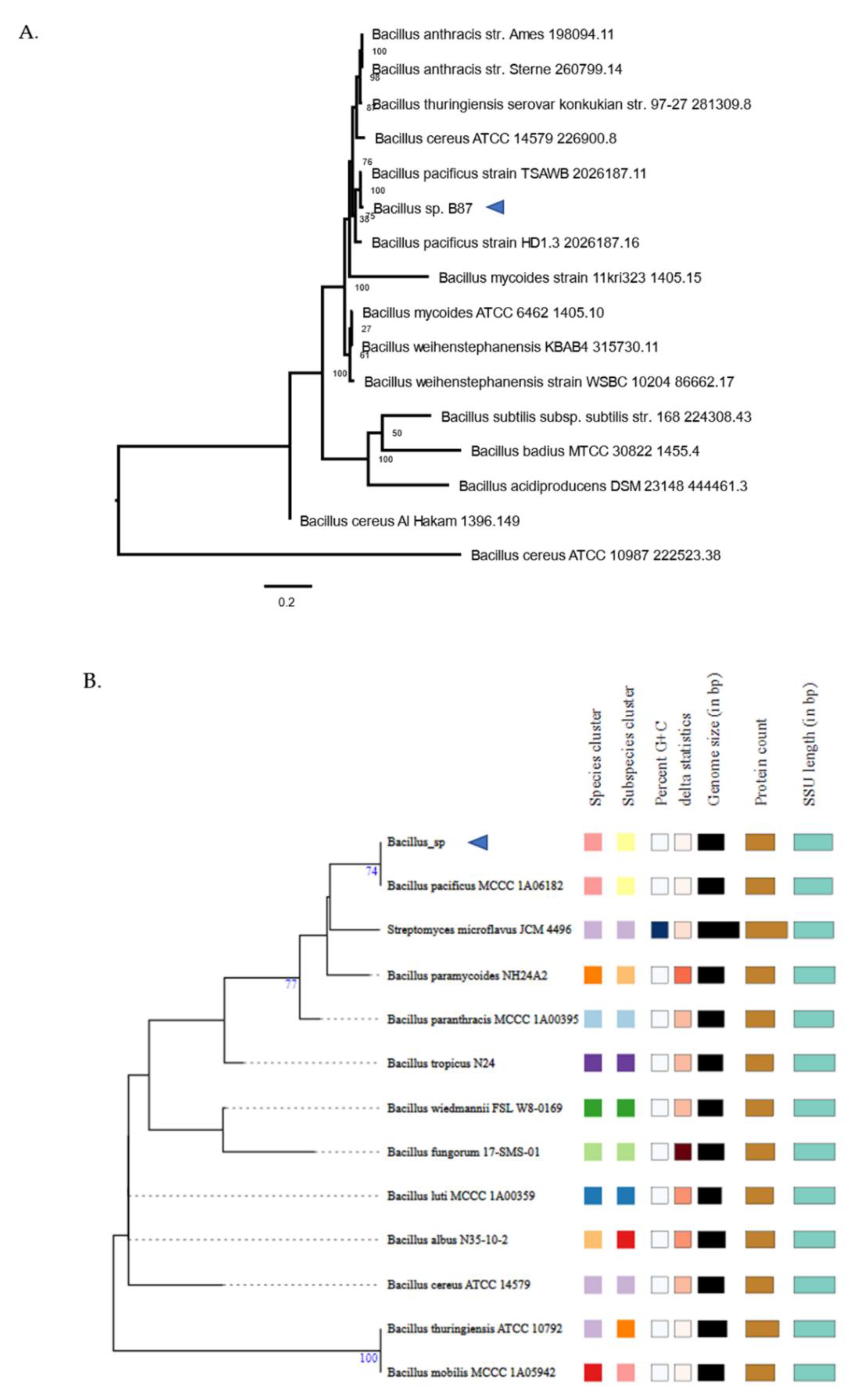
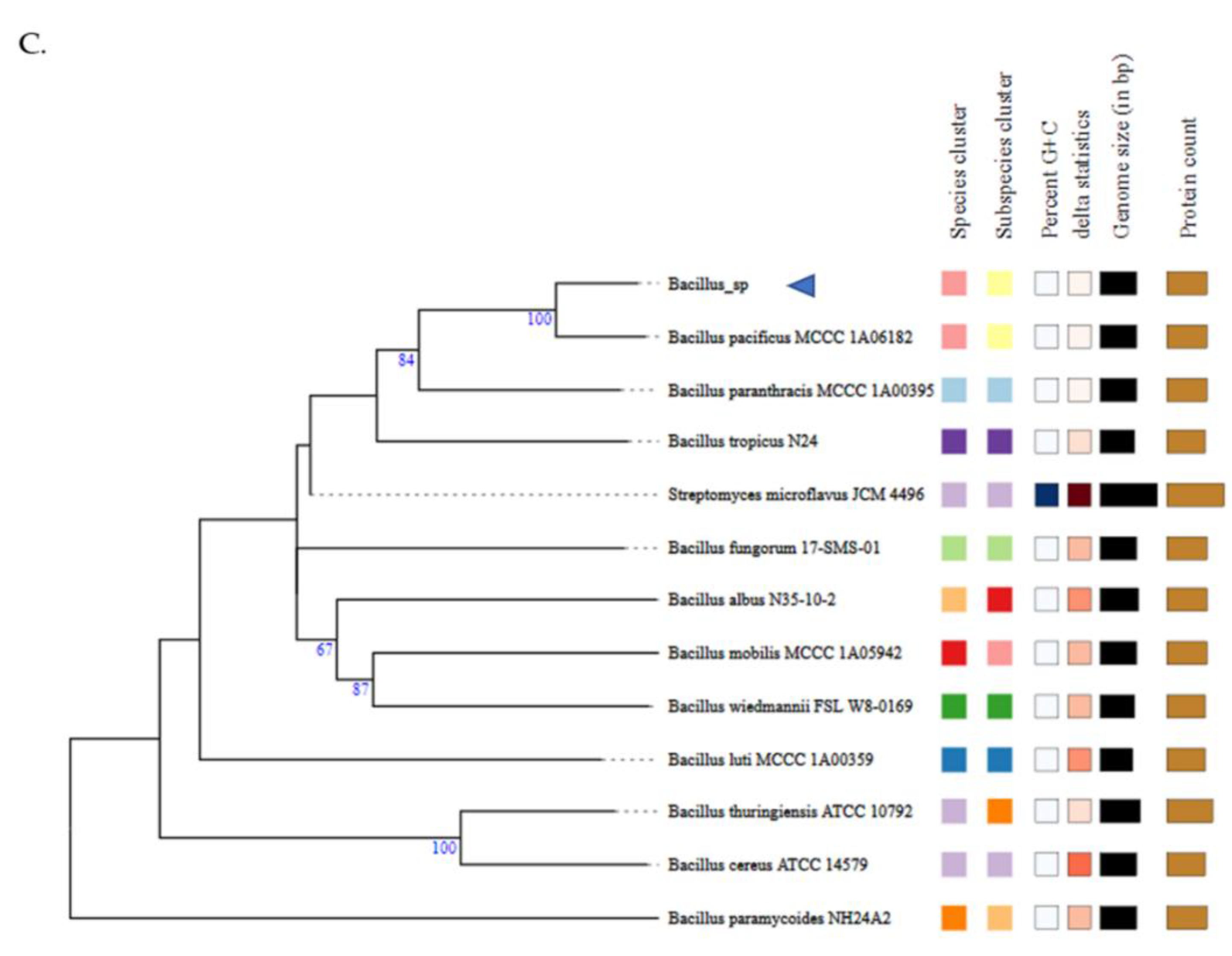
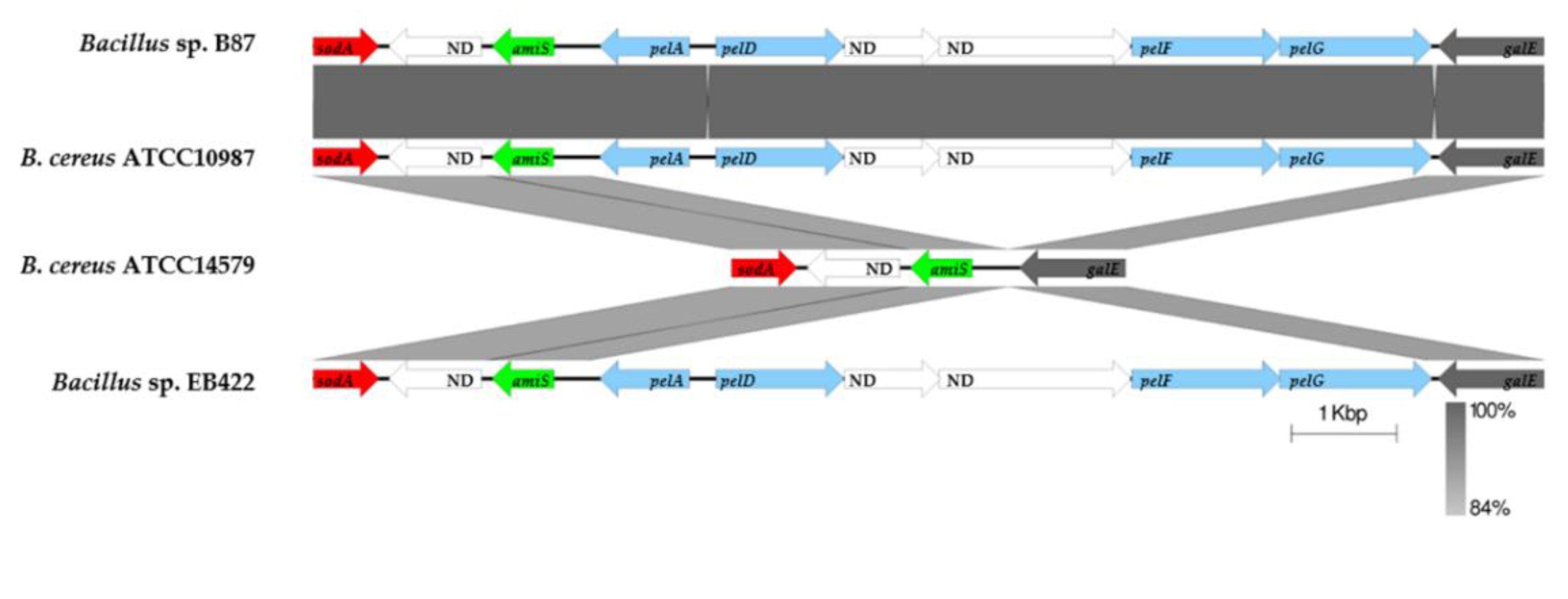
| Category | Antimicrobial Agent | Interpretation |
|---|---|---|
| β-lactam | Ampicillin (10 µg) | R |
| Amoxicillin–clavulanic acid (20 µg/10 µg) | R | |
| Penicillin (10 U) | R | |
| Aminoglycosides | Gentamicin (10 µg) | S |
| Carbapenems | Imipenem (10 µg) | S |
| Glycopeptides | Vancomycin (30 µg) | S |
| Phenicols | Chloramphenicol (30 µg) | S |
| Fluoroquinolones | Ciprofloxacin (5 µg) | S |
| Tetracyclines | Tetracycline (30 µg) | R |
| Folate pathway inhibitors | Trimethoprim–sulfamethoxazole (1.25 µg/23.75 µg) | S |
| Macrolides | Erythromycin (15 µg) | S |
| Genome Features | Chromosome |
|---|---|
| Genome length (bp) | 5,448,163 |
| Protein-coding genes | 5661 |
| GC content (%) | 35.18 |
| The number of tRNA | 77 |
| The number of rRNA | 5 |
| Contigs | 117 |
| Contig L50 | 11 |
| Contig N50 | 161,893 |
| Genes | Product | Source ID | Source Organism |
|---|---|---|---|
| CARD database | |||
| Translation elongation factor Tu | YP_006374661.1 | Enterococcus faecium DO | |
| BLA1 | Class A beta-lactamase (EC 3.5.2.6) | AAR20595.1 | B. anthracis |
| FosB | Fosfomycin resistance protein FosB | NP_831795.1 | B. cereus ATCC 14579 |
| BcII | Subclass B1 beta-lactamase (EC 3.5.2.6) => BcII family | AAA22562.1 | B. cereus |
| dfrE | Thymidylate synthase (EC 2.1.1.45) | AAD01867.1 | E. faecalis |
| NDARO database | |||
| Class A beta-lactamase (EC 3.5.2.6) | WP_063842248.1 | B. cereus | |
| Subclass B1 beta-lactamase (EC 3.5.2.6) => BcII family | WP_000799223.1 | B. cereus group | |
| Fosfomycin resistance protein FosB | WP_000943763.1 | Bacillus | |
| Tetracycline resistance, MFS efflux pump => Tet(45) | WP_063855885.1 | Bhargavaea cecembensis | |
| Biofilm Formation Genes | Product |
|---|---|
| lsrR | Transcriptional repressor of lsr operon |
| lsrK | Autoinducer 2 (AI-2) kinase LsrK (EC 2.7.1.-) |
| lsrD | Autoinducer 2 (AI-2) ABC transport system, membrane channel protein LsrD |
| lsrC | Autoinducer 2 (AI-2) ABC transport system, membrane channel protein LsrC |
| Cupin domain protein in autoinducer 2 (AI-2)-related operon | |
| N-acyl homoserine lactone hydrolase | |
| 3-hydroxy-5-phosphonooxypentane-2,4-dione thiolase (EC 2.3.1.245) | |
| Autoinducer 2 (AI-2) ABC transporter, dimeric ATP-binding protein | |
| Autoinducer 2 (AI-2) ABC transporter, substrate-binding protein |
| KEGG Orthology | Genes | Protein Product |
|---|---|---|
| Biofilm transcriptional regulators | ||
| K06284 | abrB | AbrB family transcriptional regulator, transcriptional pleiotropic regulator of transition state genes |
| K03706 | codY | Transcriptional pleiotropic repressor |
| K20480 | nprR | HTH-type transcriptional regulator, quorum-sensing regulator NprR |
| K20391 | plcR | HTH-type transcriptional regulator |
| K20390 | papR | Regulatory peptide PapR |
| K06372 | sinI | Antagonist of SinR |
| K19449 | sinR | XRE family transcriptional regulator, master regulator for biofilm formation |
| K07699 | Spo0A | Two-component system, response regulator, stage 0 sporulation protein A |
| Matrix protein-encoding genes | ||
| K06336 | tasA | Spore coat-associated protein N |
| K13280 | sipW | Signal peptidase I |
| Putative matrix polysaccharide synthesis genes | ||
| K07705 | lytR | Two-component system, LytTR family, response regulator LytT |
| K00012 | ugd | UDPglucose 6-dehydrogenase |
| K21006 | pelA | Polysaccharide biosynthesis protein PelA |
| K21009 | pelD | Polysaccharide biosynthesis protein PelD |
| K21011 | pelF | Polysaccharide biosynthesis protein PelF |
| K21012 | pelG | Polysaccharide biosynthesis protein PelG |
| eDNA synthesis genes | ||
| K01939 | purA | Adenylosuccinate synthase |
| K01923 | purC | Phosphoribosylaminoimidazole-succinocarboxamide synthase |
| K23269 | purL | Phosphoribosylformylglycinamidine synthase subunit PurL |
| Genes | Product | Source ID | Source Organism |
|---|---|---|---|
| Victors database | |||
| sodA2 | Superoxide dismutase [Mn] (EC 1.15.1.1) | 227818216 | B. anthracis str. CDC 684 |
| sigB | RNA polymerase sigma factor SigB | 227816152 | B. anthracis str. CDC 684 |
| nos | Nitric oxide synthase oxygenase (EC 1.-.-.-) | 227818215 | B. anthracis str. CDC 684 |
| codY | GTP-sensing transcriptional pleiotropic repressor CodY | 227813264 | B. anthracis str. CDC 684 |
| recA | RecA protein | 15926868 | S. aureus subsp. aureus N315 |
| phnX | Phosphonoacetaldehyde hydrolase (EC 3.11.1.1) | 47526609 | B. anthracis str. ‘Ames Ancestor’ |
| sodC | Superoxide dismutase [Cu-Zn] precursor (EC 1.15.1.1) | 227817676 | B. anthracis str. CDC 684 |
| sodA1 | Superoxide dismutase [Mn] (EC 1.15.1.1) | 227817051 | B. anthracis str. CDC 684 |
| clpX | ATP-dependent Clp protease ATP-binding subunit ClpX | 227817253 | B. anthracis str. CDC 684 |
| VFDB database | |||
| nheC | Enterotoxin C | VFG016286 | B. cereus ATCC 10987 |
| inhA | Immune inhibitor A, metalloprotease (EC 3.4.24.-) | VFG016338 | B. anthracis str. Sterne |
| nheB | Non-hemolytic enterotoxin lytic component L1 | VFG016278 | B. cereus ATCC 10987 |
| nheA | Non-hemolytic enterotoxin A | VFG016270 | B. cereus ATCC 10987 |
| BTyper tool | |||
| bpsF | Bacillus cereus exo-polysaccharide operon gene F tyrosine protein kinase [plasmid pBC218] | B. cereus str. G9241 | |
| entFM | Enterotoxin | B. cereus ATCC 14579 | |
| bceT | Diarrheal toxin | B. cereus | |
| plcA | 1-Phosphatidylinositol phosphodiesterase precursor | B. cereus ATCC 14579 | |
| entA | Enterotoxin/cell-wall binding protein | B. cereus ATCC 14579 | |
| bpsE | Bacillus cereus exo-polysaccharide operon gene E UTP--glucose-1-phosphate uridylyltransferase [plasmid pBC218] | B. cereus str. G9241 | |
| inhA2 | Immune inhibitor A precursor | B. cereus ATCC 14579 | |
| nheC | Enterotoxin C | B. cereus ATCC 14579 | |
| cerA | Cereolysin A | B. cereus | |
| bpsH | Bacillus cereus exo-polysaccharide operon gene H LytR family transcriptional regulator [plasmid pBC218] | B. cereus str. G9241 | |
| inhA1 | Immune inhibitor A precursor | B. cereus ATCC 14579 | |
| nheA | Non-hemolytic enterotoxin lytic component L2 | B. cereus ATCC 14579 | |
| nheB | Non-hemolytic enterotoxin lytic component L1 | B. cereus ATCC 14579 | |
| cerB | Cereolysin B | ||
| plcB | Phospholipase C | B. cereus ATCC 14579 | |
| sph | Sphingomyelinase C | B. anthracis str. Ames | |
| plcR | Transcriptional regulator | B. anthracis str. Ames | |
Publisher’s Note: MDPI stays neutral with regard to jurisdictional claims in published maps and institutional affiliations. |
© 2022 by the authors. Licensee MDPI, Basel, Switzerland. This article is an open access article distributed under the terms and conditions of the Creative Commons Attribution (CC BY) license (https://creativecommons.org/licenses/by/4.0/).
Share and Cite
Sornchuer, P.; Saninjuk, K.; Prathaphan, P.; Tiengtip, R.; Wattanaphansak, S. Antimicrobial Susceptibility Profile and Whole-Genome Analysis of a Strong Biofilm-Forming Bacillus Sp. B87 Strain Isolated from Food. Microorganisms 2022, 10, 252. https://doi.org/10.3390/microorganisms10020252
Sornchuer P, Saninjuk K, Prathaphan P, Tiengtip R, Wattanaphansak S. Antimicrobial Susceptibility Profile and Whole-Genome Analysis of a Strong Biofilm-Forming Bacillus Sp. B87 Strain Isolated from Food. Microorganisms. 2022; 10(2):252. https://doi.org/10.3390/microorganisms10020252
Chicago/Turabian StyleSornchuer, Phornphan, Kritsakorn Saninjuk, Parisa Prathaphan, Rattana Tiengtip, and Suphot Wattanaphansak. 2022. "Antimicrobial Susceptibility Profile and Whole-Genome Analysis of a Strong Biofilm-Forming Bacillus Sp. B87 Strain Isolated from Food" Microorganisms 10, no. 2: 252. https://doi.org/10.3390/microorganisms10020252
APA StyleSornchuer, P., Saninjuk, K., Prathaphan, P., Tiengtip, R., & Wattanaphansak, S. (2022). Antimicrobial Susceptibility Profile and Whole-Genome Analysis of a Strong Biofilm-Forming Bacillus Sp. B87 Strain Isolated from Food. Microorganisms, 10(2), 252. https://doi.org/10.3390/microorganisms10020252






